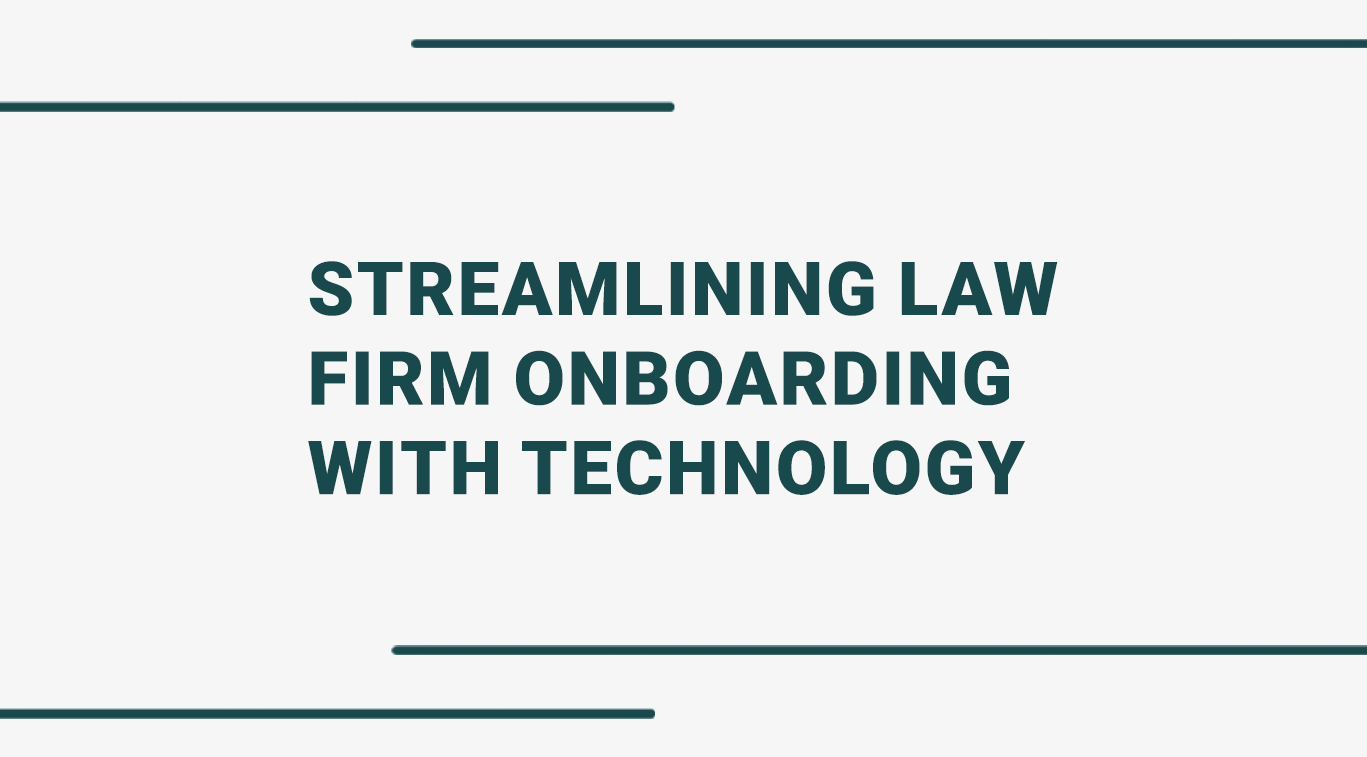Streamlining Law Firm Onboarding With Technology

Written by Maryam Khan
Blogger

The legal sector is experiencing a major technological transformation, with new solutions changing every aspect of a law firm’s operations. Artificial intelligence, legal data analytics, and digitalisation have reshaped the way lawyers practise law and how law firms manage their finances, market their services, and build client relationships. In particular, legal technology solutions have revamped the traditional onboarding process both for new clients and employees.
Traditional onboarding practices may be too slow for today’s future-facing law firms with a higher work capacity, taking on more clients, and recruiting now more than ever. Inefficient onboarding processes can cause several days for a client that requires their matter to be resolved urgently.
Moreover, the onboarding process is the starting point of the relationship between a law firm and its client or new hire. Therefore, it needs to be as streamlined as possible to make a good first impression and ensure a positive start to a potential long term relationship.
This article explores the benefits of introducing automation to onboarding processes and how the needs of law firms are changing when it comes to traditional onboarding.
Why is the onboarding process important for law firms?
Many law firms can be guilty of not establishing proper onboarding procedures when acquiring a new client or employee. Recruiters may not put in the same amount of attention, effort, and care a potential client may receive during the recruitment process during onboarding, resulting in the employee not being satisfied and looking elsewhere for jobs. Similarly, when lawyers pitch their services to clients, they should give the same attention and enthusiasm before and after acquiring the client. The onboarding process should not simply send a few documents and pleasantries and then shift focus to attract another potential client [1]. This goes completely against the principle of a client-centric profession that must provide quality client service. This can significantly harm the firm’s reputation and ability to generate client referrals or even hire new associates or trainee solicitors during recruitment cycles. Therefore, HR departments need to invest the same level of time and effort in interviewing a candidate or pitching to a client when they onboard them [2].
A successful onboarding process is crucial to the law firm’s client and employee retention strategy. These retention rates are extremely important for a law firm’s business. There is no business for a law firm without satisfied clients who generate years of work for the firm. Similarly, law firms lose out on recruiting the best talent and struggle to compete for lateral hires without satisfied employees. Having a strong onboarding process starts building a robust relationship with new clients and employees, which makes them feel more welcomed and builds a foundation of trust.
Moreover, an onboarding process is also the perfect opportunity for law firms to have a kickoff process as part of an onboarding exercise that allows clients to understand how the firm works and help manage their expectations [3]. New hires can use this opportunity to ask questions, learn about the firm and get to know the team they will be involved with. A major component of an onboarding process is to manage a new employee or client’s expectations regarding the role or project. Here is where law firms can incorporate onboarding exercises that involve specifying the exact services needed, the scope of the project and the client’s budget. Balancing these expectations and realities at the start of a relationship allows both parties to be on the same page and avoids coming into a disagreement halfway through the contract, which can be a huge waste of time while negatively impacting the overall client or candidate experience.
Furthermore, a successful client relationship begins with a law firm’s client intake process [4]. This is the first opportunity lawyers have to introduce the firm and its services to a client and discuss any potential issues that may initially arise during a project. From a hiring perspective, a strategic onboarding process also gives employees the time to ask any questions, address their concerns and get to know their new time. With the right tools and resources, law firms can create an engaging onboarding experience for both their employees and clients that is efficient and meaningful [5].
How is technology transforming the client onboarding process?
Law firms are exploring alternatives to traditional client onboarding methods to meet the increasing expectations of clients and improve the overall client experience. One way law firms are doing this is through digital client onboarding. Integrating automation and artificial intelligence into the onboarding process makes things easier for prospective clients and the law firm. Digital client onboarding with built-in identity verification functions is the perfect solution that balances providing an innovative client experience with an efficient process that meets the firm’s compliance and due diligence requirements.
Automated Onboarding & Pre-Screening Process
Automated and digital onboarding processes allow lawyers and potential employees to have meetings without taking time out from their busy lives. It can be difficult for clients to meet law firms who may operate in a different city for an onboarding meeting in person. The same goes for employees who may not be able to take time off work to attend an interview in person but can accommodate an online meeting.
The automated onboarding meeting can have pre-recorded questions with a mutually agreed-upon deadline for the clients to answer at a convenient time without having to worry about scheduling a time that works best for both parties. Some automated onboarding systems have features where an interview can be paused and continued later. This is great for clients who may not have the answer to all the questions. They can then pause the interview and complete it once they have all the necessary information [6]. If this situation occurs in person, clients would have to meet their lawyers multiple times to complete the onboarding and pre-screening process, which can be a huge inconvenience and cause delays.
Standardised Data Collection
Organisation is crucial when developing a streamlined and successful onboarding process. A standardised data collection or document storage system is needed to process client and candidate data to achieve this. Such software usually includes pre-printed forms that need to be filled out for each onboarding procedure [7]. It also includes a checklist that tracks completed steps and submitted information and notifies the other party of anything yet to be completed [8]. This allows for consistent communication and engagement between the law firm, and the client or candidate onboarded to ensure that all information submitted is accurate and complete. Moreover, data collection, record management systems, practice management systems and other legal technology software are extremely comprehensive and can be used for more than just onboarding purposes. This ensures that all the data and personal information a law firm processes is in one secure place and can be easily accessed and shared.
Digital Identity Checks
The digital and background checks involved in traditional onboarding processes can be very time consuming and cause delays. The use of technology offers a more secure and efficient way to carry out due diligence and verify a client’s identity [9]. This includes biometric technology, which law firms can use regardless of the client or employee’s location. To verify their identity for onboarding, they simply need to upload a clear picture of an identity document such as their passport or driving licence, which the software can then assess to determine whether it is genuine or fraudulent [10].
This is beneficial for those onboarded as it allows them to complete the verification process from the comfort of their home without bringing the documents with them in person [11]. Clients may not have their passports physically because they may be applying for a visa or are getting their passports renewed. This should not prevent them from completing an onboarding process, especially if law firms can use the right technology to verify a digital copy. Additionally, completing an ID check at the client or candidate’s convenience makes the firm seem more flexible and accommodating without worrying about scheduling a time for an in-person document check [12]. Lastly, digital identity verification is an important tool for the right to work checks for employees hired from international law firms that regularly hire lawyers worldwide. Remote working has eliminated the geographical mobility barrier when recruiting top talent allowing law firms to hire lawyers worldwide irrespective of their location. As a result, it is important to have a streamlined identity and right to work verification solution that is quick and accurate.
Easy Fund Verification
Fund verification is also a crucial component when onboarding clients alongside ID authentication. Before providing any legal services, law firms need to ensure that their customers are whom they claim to be before building a professional relationship. This is extremely important when law firms advise on high-value transactions requiring certain compliance, AML and KYC verification requirements [13]. Digital technology can capture real-time data from a client’s bank account to verify the source of their money. Using a comprehensive digital solution can increase efficiency and ensure that the due diligence carried out is of a high standard. Additionally, clients can do this through mobile applications that securely access client bank accounts and process data without sending emails, photographs, and PDFs of bank statements containing confidential financial information [14].
Cloud Security
Using legal cloud technology for onboarding allows law firms to control how the data is processed and shared [15]. This ensures that sensitive information is protected by strict access controls and monitored. There are many benefits of using cloud technology to process client information alongside other data shared across the firm. Legal cloud solution platforms are embedded with top-notch security measures which keep personal and confidential information safe [16]. When using a law firm private cloud, all information can be securely accessed by law firm employees, making the onboarding process quicker, more efficient and secure [17].
Video Conferencing Technology
Video conferencing tools are the best alternative to face-to-face meetings, allowing law firms to build strong relationships with potential clients or employees. It is important to have face-to-face interaction during a remote onboarding process which makes video conferencing technology important that law firms can benefit from when remote legal work is the only option [18]. Through video conferencing software, law firms can virtually introduce any potential clients or employees to the team, allowing them to understand the firm’s environment and culture. This is a much better alternative to simply communicating through emails or conducting telephone interviews, where conversations can be misinterpreted and aren’t as meaningful.
Final Words
Law firms need to prioritise delivering an onboarding solution that eliminates the delays caused by traditional methods of onboarding a client or employee. Digital onboarding solutions streamline client and employee data collection, ensure transparency for compliance and due diligence purposes and are far more efficient. Using the latest technology will allow firms to develop a strong relationship with potential clients and employees when meeting for the first time or during the onboarding process while complying with due diligence requirements, ensuring greater efficiency and working at a much faster pace.








